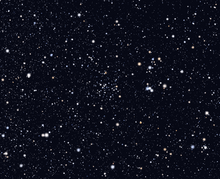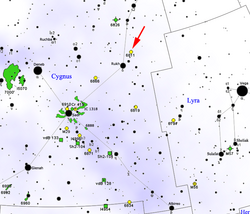Astronomy:NGC 6811
| NGC 6811 | |
|---|---|
 | |
| Observation data (2000.0 epoch) | |
| Constellation | Cygnus |
| Right ascension | 19h 37m 17s[1] |
| Declination | +46° 23′ 18″ |
| Distance | 3600 ly[2] (1107 pc[2]) |
| Apparent magnitude (V) | 6.8 |
| Apparent dimensions (V) | 13' |
| Physical characteristics | |
| Estimated age | 1.00±0.17 Gyr |
| Other designations | Cr 402 |
NGC 6811 is an open cluster in the constellation of Cygnus,[3] near the constellation of Lyra.[4] It has an angular size half that of the full Moon and includes about 1000 stars[5] of roughly similar magnitude.[3][6] It has also been called "The Hole in the Cluster" because of its dark center.[6][7]
Features
NGC 6811 lies far away from the galactic plane, a feature it shares with many other old open clusters.[6] It is 1107 ± 90 parsecs (about 3,285 light years) distant[2][8] and approximately 4-6 parsecs (14–20 light years) in diameter,[6][9] with a total luminosity of 2100 suns.[9] Approximately 1.00 ± 0.17 billion years old, the cluster probably contained some 6000 stars at birth,[4] but gravitational interactions and stellar evolution have since reduced the number substantially. A recent study reported 377 confirmed member stars, with spectral types ranging from mid-F to early K, and surface temperatures relatively similar to the Sun's.[4] The same study argued that the original cluster population likely included 8 O-type stars and 125 B-type stars, but all have evolved off the main sequence and are undetectable.[4] Sixteen stars have been observed to vary in brightness, twelve of which are Delta Scuti variables.[10] The cluster's Trumpler classification is III 1r—it is "a rich cluster with equally bright stars with no noticeable central concentration".[6] The stars do, however, have an unusual (if not concentrated) distribution, with an apparent stellar corona surrounding the core, leaving the impression of a hole.[6]
Observation
NGC 6811 was first observed by John Herschel in 1829 and was added to his General Catalogue of Nebulae and Clusters in 1864.[11] The cluster has been the subject of study by the Kepler mission, with the aim of characterizing its stars' rotation rate, age, and distance to help the hunt for exoplanets.[4]
NGC 6811 is best observed from Earth in the Northern Hemisphere in summer. In these conditions it lies close to the zenith during the night, northeast of Delta Cygni.[3] It is considered an aesthetically pleasant object for amateur astronomers, even if the brightest members are just 10th magnitude objects. It appears as a hazy patch in 10x binoculars, but it is best seen at around 70x with a moderate-aperture telescope.[9] It has been described by amateur astronomers as a "smoke ring of stars" or "a jeweled mask a woman might wear at a masquerade ball".[6]
Planets
Two planets (Kepler 66b and Kepler 67b), orbiting Sun-like stars in the NGC 6811 cluster, have been discovered by the Kepler mission using the transit method.[2] Both planets are smaller than Neptune and are both the first sub-Jupiter planets and the first transiting planets discovered orbiting stars within an open cluster.[2] Given that the age and distance of the cluster have been accurately measured, the two planets are among the few of which age and distance are accurately known.[12] This finding suggests that the frequency of planets in clusters is similar to that in stars not belonging to clusters or associations[2][12] and that planets can form and survive in environments more crowded and violent than the one of our own Sun.[5]
See also
References
- ↑ "NGC 6811". SIMBAD. Centre de données astronomiques de Strasbourg. http://simbad.u-strasbg.fr/simbad/sim-basic?Ident=NGC+6811.
- ↑ 2.0 2.1 2.2 2.3 2.4 2.5 Meibom, S. R.; Torres, G.; Fressin, F.; Latham, D. W.; Rowe, J. F.; Ciardi, D. R.; Bryson, S. T.; Rogers, L. A. et al. (2013). "The same frequency of planets inside and outside open clusters of stars". Nature 499 (7456): 55–58. doi:10.1038/nature12279. PMID 23803764. Bibcode: 2013Natur.499...55M.
- ↑ 3.0 3.1 3.2 Ayiomamitis, Anthony. "NGC 6811". Astronomy Magazine. Kalmach Publishing Co.. http://cs.astronomy.com/asy/m/starclusters/450560.aspx.
- ↑ 4.0 4.1 4.2 4.3 4.4 Meibom, S. R.; Barnes, S. A.; Latham, D. W.; Batalha, N.; Borucki, W. J.; Koch, D. G.; Basri, Gibor; Walkowicz, L. M. et al. (2011). "The Kepler Cluster Study: Stellar Rotation in Ngc 6811". The Astrophysical Journal 733 (1): L9. doi:10.1088/2041-8205/733/1/L9. Bibcode: 2011ApJ...733L...9M.
- ↑ 5.0 5.1 Balouchi, Shari. "Crowded Clusters Can Host Planets, Too". Sky and Telescope. http://www.skyandtelescope.com/news/Crowded-Clusters-Can-Host-Planets-Too-214641151.html.
- ↑ 6.0 6.1 6.2 6.3 6.4 6.5 6.6 Stephen James O'Meara (30 June 2011). Deep-Sky Companions: The Secret Deep. Cambridge University Press. pp. 389–. ISBN 978-1-139-50007-4. https://books.google.com/books?id=v859bKO0A4gC&pg=PA389. Retrieved 9 July 2013.
- ↑ L. Phil Simpson (2012). Guidebook to the Constellations. Springer. pp. 505–. ISBN 978-1-4419-6941-5. https://books.google.com/books?id=7gde2t9ta4QC&pg=PA505. Retrieved 9 July 2013.
- ↑ Janes, K.; Barnes, S. A.; Meibom, S. R.; Hoq, S. (2013). "Ngc 6811: An Intermediate-Age Cluster in the Kepler Field". The Astronomical Journal 145 (1): 7. doi:10.1088/0004-6256/145/1/7. Bibcode: 2013AJ....145....7J.
- ↑ 9.0 9.1 9.2 Craig Crossen; Gerald Rhemann (27 January 2004). Sky Vistas: Astronomy for Binoculars and Richest-Field Telescopes. Springer. pp. 67–. ISBN 978-3-211-00851-5. https://archive.org/details/springer_10.1007-978-3-7091-0626-6. Retrieved 9 July 2013.
- ↑ Luo, Y. P.; Zhang, X. B.; Luo, C. Q.; Deng, L. C.; Luo, Z. Q. (2009). "Variable stars in the open cluster NGC 6811". New Astronomy 14 (6): 584. doi:10.1016/j.newast.2009.02.005. Bibcode: 2009NewA...14..584L.
- ↑ "The NGC/IC Project". Results for NGC 6811. http://www.ngcicproject.org/pubdb.htm.
- ↑ 12.0 12.1 "First Transiting Planets in a Star Cluster Discovered". Harvard-Smithsonian Center for Astrophysics. 2013-06-26. http://www.cfa.harvard.edu/news/2013/pr201317.html.
External links
 |


